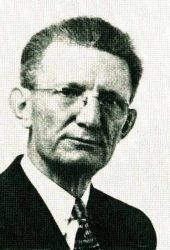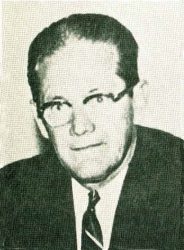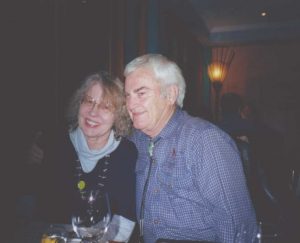The beginning
 |
| Hiram Hadley |
Our university began In 1888, just 7 years after Billy the Kid was shot locally by Pat Garrett, as the Las Cruces College. It was formed by a group of local citizens and consisted of 3 faculty and 40 students. Tuition was $40. The following year it became the New Mexico College of the Agriculture and Mechanic Arts, or briefly New Mexico A&M. It was not until 1960 that it became New Mexico State University. Hiram Hadley was the first President of the college, and first Head of the Mathematics Department. It was a rough and tumble time, the only member of what would be our first graduating class was murdered before completing his degree. (Hadley)
Early years
 |
| John Branson |
In the years before WW II, the college was focused on practical aspects of agriculture, engineering, and teacher education. Mathematics played a service role. Several departments, including mathematics, had a Master’s degree, but there were no PhD programs. Clarence Hagerty and John Branson served as Heads of what was then the Department of Mathematics and Astronomy for nearly all of the period from 1892 – 1941. The department had one or two faculty until the mid 1920s, and grew to 5 faculty by the late 1930s. The first faculty member with an earned PhD came in 1933, and by 1937 3 faculty had PhDs and 2 masters. Pay for a new PhD professor in 1933 was $1600. (Branson)
Transformative years
 |
| Earl Walden |
WW II hit New Mexico A&M very hard. Students were scarce, and the legislature was pushing to turn it into a vocational school. John Branson was appointed to his second term as President of the college at this time. Earl Walden replaced him as Head of Mathematics. Branson fought the push for vocational status, while Walden and fellow mathematics faculty Westhafer spearheaded a push for the formation of a liberal arts direction in the College of Arts & Sciences. It was at this time that the college made its main steps towards being a rounded academic institution, and began a new emphasis on graduate education. In the late 1950s, Mathematics, Physics, and Engineering instituted doctoral programs. At the end Walden’s service as department head, New Mexico A & M became New Mexico State University, the department had 9 faculty, and Mathematics graduated the first PhD student from our institution in 1960. (Walden)
Golden era
 |
| Carol and Elbert Walker |
Ralph Crouch became department head in 1961. He, and the recently hired Elbert Walker began to vigorously recruit strong research faculty. By 1966 the department had added Ed Gaughan, Jack Giever, John Irwin, Art Kruse, Fred Richman, Ed Thorp, and Bob Wisner, and Carol Walker. Over this time, the department graduated 17 PhD students and 16 Master’s students. They received two major awards from the NSF that were game changing. The first was for money to build what is now called Walden Hall. It allowed the department room to grow. The second was a major award for an NSF Center of Excellence that provided funds for the department to grow. And grow it did. By the early 1970s the department had expanded to 34 tenure-track faculty, adding Dave Arnold, Dick Bagby, Don Johnson, Bill Julian, Joe Kist, Warren Kruger, Ray Mines, Chuck Swartz, Frank Williams, and Joe Zund, among others. The department had gone from one without a PhD program, to one with a strong international presence in aspects of Algebra, Analysis, and topology, among others in a decade. World-class researchers came to NMSU for visits, both for individual collaboration such as Reinhold Baer coming for a year in 1963, and through the Holiday Symposium series. Faces came and went over the next several decades. Among new faces were John Dupree, Roger Hunter, and Doug Kurtz in the later 1970s; Dave Finston, Jerry Lodder, Ross Staffeldt, David Pengelley, and Hung Nguyen in the 1980s; and Mai Gehrke, Joe Lakey, Pat Morandi, and Irena Swanson in the early 1990s. Carol Walker was the department head from 1979-1993, and found the new home of Science Hall to house the research faculty. Walden Hall was filled with the Learning Center for first-year mathematics, lead by Kitty Berver. Throughout, the period from 1970-2000 the department remained between 32-34 tenure-track faculty.
Recent times
From 2000 to the present, the department has bit by bit faced difficulties. Several people served as head, the longest was Joe Lakey from 2010-2018, but all faced the same situation. Faculty lines were often not returned by the administration when people left or retired and budgets were frozen or scaled back. We currently have 18 tenure-track faculty in the department, down from a consistent level of 32-34 for decades. Research and publication remains vibrant with many excellent faculty in the department. We are retaining depth, but struggle with breadth, and the hair on our faculty is becoming thinner and more gray. We face challenges, but also have opportunities, resources (thanks to help from some beyond the norm), and a strong faculty to utilize them. We look forward to starting the next chapter.
Contributions of our department
- The first president of the institution.
- A president to guide the institution through its most vulnerable time.
- A primary force in changing from an agricultural college to a full spectrum university.
- The first PhD graduate.
- One of the strongest research departments in turning us into a Carnegie Research University
Today you will see Hadley Hall, where our current administration resides, Branson Library, Walden Hall that houses part of the math department, the Walker Room where our department holds colloquia, and our university research award is the Westhafer.
